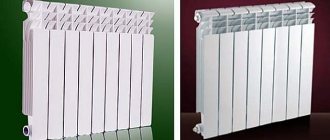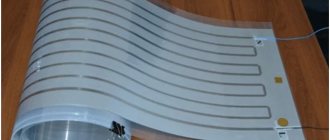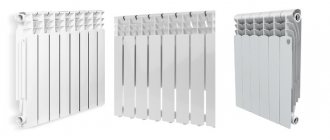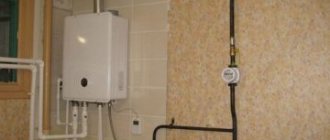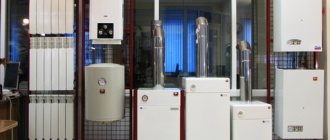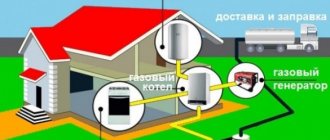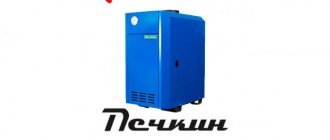It is recommended to heat the living room or dining room using infrared panels, which allow creating zones of increased thermal comfort.
According to the principle of operation, all electric heating devices can be divided into convection (radiators, convectors, fan heaters, underfloor heating systems) and radiant (various models of infrared heaters).
- When the first ones operate, warm air rises to the ceiling and displaces cold air from there, which, in turn, is sent down. Thus, the process of convection occurs.
- Electric heating devices of the second type operate on the principle of sunlight. Thermal radiation from a device hanging under the ceiling or on the wall is transmitted to the floor, furniture, and the human body, which heat up as if from sunlight, and at the same time they themselves begin to give off heat to the air.
Some experts also classify electric boilers as electric heating devices.
True, the PETN spirals of such devices heat water, not air. But since the latter is used, in particular, for heating a home, it seems that the boiler can rightfully be classified as electrical equipment. Below we will look at the features of various types of electric heating devices, and then we will try to determine which of them will be appropriate in an apartment, and which will be suitable for a small country house, cottage, etc. expert opinion Dmitry
Shabanov, senior manager of the sales department of the Engineering Systems Agency
Quite often, owners of apartments and country cottages purchase infrared heaters for their “possessions.” However, it must be taken into account that a person exposed to the rays of such a device for a long time will most likely not feel very comfortable. It's like spending the whole day in the sun, except you won't get a tan. Therefore, I do not recommend installing infrared panels in the living room or, say, in the bedroom above the bed.
It is much more reasonable to place them in “passage” places: the living room, on the veranda, etc. However, one should not think that long-wave infrared radiation is harmful to the human body. After all, many have probably heard about the benefits of therapeutic procedures in infrared cabins. This therapy helps fight colds and cellulite. So there is no need to be afraid of infrared heaters. The main thing is to observe moderation (you can, for example, choose a low-power device).
Mikhail Danilov Director of Marketing and Sales of JSC Elektroscandia
In city apartments, central heating usually combats the cold. Therefore, the use of electric heating devices can only be recommended as a supporting, safety option (for example, during off-season periods when hot water may be turned off). As such an alternative, I would advise choosing an oil radiator or convector. But “warm floors” are advisable if the room has a tiled or stone floor. In my opinion, it is not advisable to heat wooden floors (for example, parquet).
Varieties
Most often, the classification of heating devices is carried out according to the following criteria:
- the coolant used, which can be heated water, gas or even air;
- material of manufacture;
- operational characteristics: size, power, installation method and the ability to regulate the heating rate.
It is better to select the optimal option, taking into account the characteristics of the building’s heating system, operating conditions, observing all the requirements for heating devices.
In addition to the performance of devices, it is worth considering the possibility of their installation. For example, in the absence of gas supply and the impossibility of organizing water heating, the only option will be electrical appliances.
Water system
The most commonly used and therefore have the widest range of heating devices are water heating systems. This is explained by their good efficiency and optimal level of costs for acquisition, installation and maintenance.
Structurally, the devices are not too different from each other. Inside each there are channels for the flow of hot water, the heat from which is transferred to the surface of the device, and then, using convection, to the air of the room. For this reason they are called convection.
The following types of radiators can be used in water heating systems:
- cast iron;
- steel;
- aluminum;
- bimetallic.
All of these heating devices have their own characteristics, due to which they are selected for each specific case depending on the area of the room, the nuances of installation, the quality and type of coolant (which is sometimes antifreeze).
The power of each device is regulated by the number of sections, which can be selected by almost anyone. Although, if the estimated length of one battery is more than 1.5–2 m, it is recommended to install two smaller devices next to each other.
Cast iron batteries
Cast iron was one of the most popular materials in domestic heating systems. His choice, as a rule, was due to the relatively low cost. Later, such devices began to be used less frequently, since they have a small heat transfer coefficient (only 40%), due to which the power of one section is approximately 130 W. Although they can still be found in old-style systems. In modern interiors, designer models of cast iron radiators are sometimes used.
The advantages of such devices are a large surface area that transfers heat to the room, and a long operating period (up to 50 years). Although there are still more disadvantages - these include the relatively large volume of coolant used (up to 1.4 liters), the difficulty of repair, and the inertia of heating, due to which the temperature of the device increases relatively slowly, and even the need for periodic (at least once every 3 year) cleaning. In addition, heavy sections are very difficult to install.
Aluminum radiators
The use of aluminum radiators allows us to ensure the maximum level of heat transfer - the power of the section can reach 200 W (which is enough to heat 1.5–2 sq. m).
Their cost is quite affordable, and their low weight allows you to install them yourself. True, the operation of the device is possible for only 20–25 years.
Bimetallic batteries
Their advantages include the presence in the design of convection panels that improve air circulation over the surface, ease of installation of devices for regulating the intensity of coolant flow, as well as ease of installation. The radiator section, with a power of up to 180 W, is capable of heating about 1.5 square meters. m area.
Despite the advantages that such heating devices have, there are also problems with their use. For example, for bimetallic radiators it is not recommended to dilute water with antifreeze, which, although they do not allow the system to freeze, negatively affects the internal surfaces of heating devices.
In addition, these options are the most expensive of all that are used in a water heating system.
Steel panel batteries
These heating devices consist of two ribbed plates made by casting. They have a sealed circuit inside, which is filled with a coolant that provides space heating.
Thanks to its ribbed shape, the steel battery has efficient heat dissipation. Thermal conductivity of steel is similar to cast iron. But steel units have much thinner walls than cast iron products and therefore they heat up much faster. To warm up a cold living space, it will take 2 times less time. Such high productivity is achieved by convection.
The devices are designed for an operating pressure of 10 - 11 atmospheres, which corresponds to the technical characteristics of the central heating system. Some models of modern steel apartment heating radiators are equipped with ventilation (convection) holes that create a thermal curtain for cold air coming from a window or door.
After assembly is completed, the entire structure is coated with a special paint that protects against mechanical and various chemical damage. If you have any doubts about which battery to choose for your apartment from the range offered, you need to carefully check the uniformity of application of the coloring composition - this is precisely the circumstance that often affects the service life of heating equipment.
The fact is that poorly protected areas can cause corrosion. Panel radiators made of steel of standard models are designed to heat the working environment up to 85-90 degrees, but sometimes they can withstand temperatures up to 100-110 degrees. The quality of water circulating in such devices is subject to minimum requirements with an acceptable pH threshold of 3-9.5 units.
When deciding which radiators are best installed in an apartment, you need to remember that experts do not advise leaving steel products without coolant for a long time. The reason is that when in contact with air, this metal undergoes corrosive processes.
Steel radiators have a classification system, which is based on the number of panels and convectors. For example, type 10 corresponds to one panel. It is considered the simplest and most cost-effective option, but the absence of a convection heat exchanger reduces heat transfer. In turn, type 21 consists of 2 panels and 1 convector between them.
Steel units also differ in size. Their length ranges from 400 to 3000 millimeters and height from 200 to 900 millimeters. The variety of parameters allows you to choose the best heating batteries for an apartment with rooms of different sizes.
The advantages of steel panel units include:
- small thickness and weight;
- high heat transfer coefficient;
- ease of installation;
- quick heating of rooms;
- affordable price;
- minimum requirements for water quality;
- the ability to choose a model with a certain number of convectors.
As for the disadvantages of steel batteries, they appear in apartments equipped with autonomous heating. The fact is that the dimensions of the structures cannot accommodate a sufficient volume of water, and therefore the boiler will have to be turned on frequently to maintain the required temperature.
This in turn will lead to an increase in energy consumption. If the apartment is connected to a central heating system, this feature does not matter.
Before choosing a steel radiator, you need to familiarize yourself with the quality of the coolant. When the central heating system does not have clean water, the unit will not last long, since its internal surface usually does not have a protective coating.
In a steel panel structure, thin walls do not withstand water hammer, the presence of which is indicated by the presence of extraneous sounds in the system in the form of clicks, murmurs, and crackling sounds.
Electric heating devices
All electrical appliances used if it is impossible to install a water heating system have different features and characteristics - from power to principles of heat generation. At the same time, the main disadvantages of any such equipment are the high cost of operation and the need to install an electrical network capable of withstanding heavy loads (with a total power of electric heaters of more than 9–12 kW, a network with a voltage of 380 V is required). Each variety has its own advantages.
Convection appliances
The design of electric heating devices of this type allows you to quickly heat the room with the help of air flows moving through them.
Air enters the devices through holes in the lower part, it is heated using a heating element, and the exit is ensured by the presence of upper slits. Today there are electric convectors with a power of 0.25 to 2.5 kW.
Infrared heating
By choosing heating devices whose operating principle is based on the radiation of heat waves in the infrared range, the owner of a private home or other premises receives the following advantages:
- a noticeable reduction in electricity consumption compared to traditional electrical equipment (within 30%);
- no reduction in oxygen content in the air, which relieves people in the room from headaches;
- very high heating speed (even a cold room warms up within a few minutes).
Electric infrared heaters are usually used. Much less common are gas appliances intended mainly for heating streets, production workshops and sites or cottages.
Classification of devices for infrared heating is made according to the method of emitting waves. There are film devices that transmit radiation from resistor conductors located on the surface of a special film to surrounding objects. Power – within 800 W per 1 sq. m.
The second type is carbon. In them, radiation comes from a spiral inside a sealed glass flask. Household appliances of this type have a power from 0.7 to 4.0 kW.
The advantage of the former is the ability to use them as electric heated floors. While carbon heaters are much more powerful, although they require increased fire safety measures.
Gas heating
In order to reduce heating costs, gas-fired heating appliances are often used. One of the simplest types of such equipment is a gas convector, connected either to a gas supply system or to a liquefied propane cylinder. In this case, the burner does not come into contact with the surrounding atmosphere, and oxygen enters it through a special pipe (which can be taken outside to maintain normal indoor air quality).
These types of heating devices have high power (up to 8 kW or more) and are relatively cheap to operate due to the low cost of energy.
The disadvantages include: the need to register with regulatory organizations, the provision of high-quality ventilation and the need for periodic cleaning of nozzles. In addition, if equipment malfunctions, the amount of harmful carbon dioxide in the room may increase. Therefore, such devices are rarely used in apartments and other premises with constant occupancy - whereas, for example, for a dacha or garage they can be simply irreplaceable.
Source
No dust or odor
If a “slow” radiator is not to your liking, we recommend purchasing a more “efficient” device – an electric convector. It will give you warmth within a few seconds after switching on, because heating of the home in this case occurs due to direct contact of the air with the heating element (tubular heating element). And no oil as an intermediary.
During convection, the mutual movement of warm and cold air masses occurs
Modern convectors are partly reminiscent of the electric fireplaces and reflectors familiar to us from childhood (popularly called “plates”), but without their disadvantages. The devices of our youth had open heating elements on which dust burned intensely. This made the room feel stuffy, and it had to be ventilated, causing the room to get cold again. To avoid such troubles, the heating elements of current convectors are sealed in a special metal casing with “ribs”. As a result, the heating surface area increases, and the problem of dust combustion disappears.
Unlike oil radiators that are quite massive, but still capable of moving within the space required by the user, convectors are designed for rigid mounting on the wall. Fortunately, the design of most models on the market is very attractive, and they fit perfectly into the interior of any room.
Modern convectors have many modifications. For example, there are special splash-proof convectors for bathrooms, decorative models made of transparent glass ceramics, etc. According to sellers, products from Stiebel Eltron, Siemens (Germany), Nobo (Norway), Noirot, Atlantic (France), costing from $100 to $150, are in greatest demand among buyers.
Content:
When the warmest place in the apartment is the kitchen, where the stove is running, or the bathtub with hot water, you should think about purchasing a heater.
The choice of a heater is influenced by the tasks it performs, the method of its connection and technical characteristics.
Different types of this equipment can act as the main or additional source of space heating. There are also electric heaters and devices connected to the water supply system.
Heat from the outlet. Electric heaters
- Convectors.
- Oil radiators.
- Infrared heaters.
- Heated towel rails.
Each of them acts as an additional heat source. When choosing, it is important to take into account the capabilities of the heaters, as well as their place of operation. Let's talk about them in more detail.
Convectors
A distinctive feature of their operation is the low heating temperature of the housing at high power.
This technique can heat both a small room and a large warehouse.
A place under the sun
We already talked about the operating principle of infrared heaters at the beginning of the article. Therefore, in order not to repeat ourselves, we will immediately move on to the description of their technical characteristics. Let's start with the fact that “solar heaters” can be used in a wide variety of premises, both residential (apartments, country houses, country cottages) and industrial (warehouses, shops, offices, etc.). Such diversity is not accidental, because devices of this type create a comfortable atmosphere in the room without heating the air, without creating noise and without disturbing dust at all.
By the way, an infrared heater is the only electric heating device that allows local heating. By placing the device, say, above a desktop, you can create the most comfortable conditions for a sitting person without heating the entire room. Naturally, this makes it possible to significantly save energy. The main thing is to correctly distribute heat sources. To do this, first calculate the total power required to heat the room as a whole, and then a certain number of infrared heaters are placed in the most suitable places for this. When calculating, an important role is played by the height of the ceilings, type of room, etc.
A wide range of infrared heaters today are produced by Energoinfra (Sweden), Pyrox (Norway), Stiebel Eltron, etc. The domestic manufacturer is also well represented on the market. Thus, devices produced by Moscow are practically not inferior to imported analogues. At the same time, domestic “sun” is cheaper. A foreign device with a power of 1.2 kW will cost $160–170. A domestic device of the same power will cost approximately $120.
Modern heating system elements
Now let's talk about which heaters are connected to the water supply system.
Many apartments still have cast iron radiators installed. A large, repeatedly painted ribbed heating “dinosaur” that has probably survived more than one generation of residents. Every winter you hear the plumbers turn on the heating, slowly, day after day, the radiator becomes warmer, but not always enough for the house to be warm without additional heating sources.
Heating radiators
Allowed us to forget about such problems with providing heat to living quarters.
Aluminum, steel or bimetallic - any of these heaters will deal with the winter cold. The choice may be influenced by the qualities the user expects from the radiator. So, steel ones are the most durable and can withstand large pressure drops. Aluminum ones conduct heat well and are an order of magnitude cheaper, while bimetallic ones combine all the advantages of the two types, excluding their disadvantages. Radiators differ not only in the metal from which they are made, but also in the number of sections, the distance between them and power. Size will matter when mounting under a window. If you place a small heater under a wide window opening, it will not be able to cut off all the cold air, and there will be no point in having a radiator.
The radiator itself does not produce heat. Hot water is located inside its body and heats the walls, so the heat is evenly distributed throughout the room.
Let us immediately note that the dismantling of old batteries and the installation of new ones should only be carried out by qualified specialists. If you decide to do this yourself, warn your neighbors in advance about the possibility of a “local flood.” It can occur if you do not close the riser and drain all the water before starting work.
Cast iron radiators for apartments
Such heating devices are familiar to everyone, since residential buildings in the Soviet years used bulky batteries, for the production of which cast iron was used. Now heavy heating units are becoming a thing of the past, giving way to modern and at the same time powerful, efficient and stylish analogues.
Cast iron as a material has excellent thermal conductivity, heats up for a long time and also cools down for a long time. It is durable and reliable, able to withstand operating pressures reaching 25 - 30 atmospheres.
Cast iron units are not at risk of water hammer, they are universal and can function with pipes made of different materials. If you purchase heating appliances for an apartment made of cast iron, you will not need to replace the entire pipeline.
After prolonged contact with the coolant from inside the radiator, a black precipitate gradually accumulates on its walls, which forms a film that prevents oxygen from penetrating the manufacturing material.
Provided that operating standards are met, cast iron batteries rarely fail as a result of metal destruction. Modern appliances are coated on the outside with a special protective paint. Therefore, there is no need to paint them often. Thanks to their smooth surface, almost no dust collects on them and no gases form inside. There is no need to constantly bleed air from cast iron radiators in order to remove air pockets.
Modern analogues differ in appearance and size. This circumstance significantly helps to solve the problem of how to choose a cast-iron battery to ensure comfortable living in the room and taking into account the design of the room. Thus, products from foreign manufacturers, designed in retro style, are decorated with ornaments and castings.
The cast iron heating structure can be expanded depending on the size of the room. The number of sections that need to be selected depends on a number of parameters:
- number of windows and doorways;
- square footage of the room;
- climate features.
In domestic batteries, the filling volume is 1.3 liters, and in foreign ones - 0.8 liters. Products from such imported manufacturers have an optimal balance between price and quality: Guratec, Demir Docum, Konner, Roca and others (read: “What is good about the Konner cast iron radiator - the advantages and rules for installing the Konner heating battery”). Russian and Belarusian products of the MS-140 and BZ-140 series have proven themselves well.
Previously, strong brackets were hammered into the wall to secure cast iron radiators, but today, for stylish heating devices, manufacturers provide floor mounting.
Advantages of cast iron heating radiators:
- affordable price;
- strength and reliability;
- compatibility with pipes made of various materials;
- easy and long-term operation;
- absence of corrosion processes;
- minor requirements for water quality.
The disadvantages of these heating devices include:
- Heavy weight, which seriously complicates installation.
- To fix it on the wall, you need to use bulky brackets, which may not fit into the style of the room.
- Not all cast iron products correspond to modern apartment design.
- Since cast iron has poor inertia, it cools slowly, which is not always an advantage, since it is not always possible to quickly adjust the optimal temperature in the room.
In a private house where autonomous heating is installed, the operation of such batteries is expensive. That is why their owners are so interested in the question of how to choose the right heating radiator for their home, taking into account its technical characteristics.

